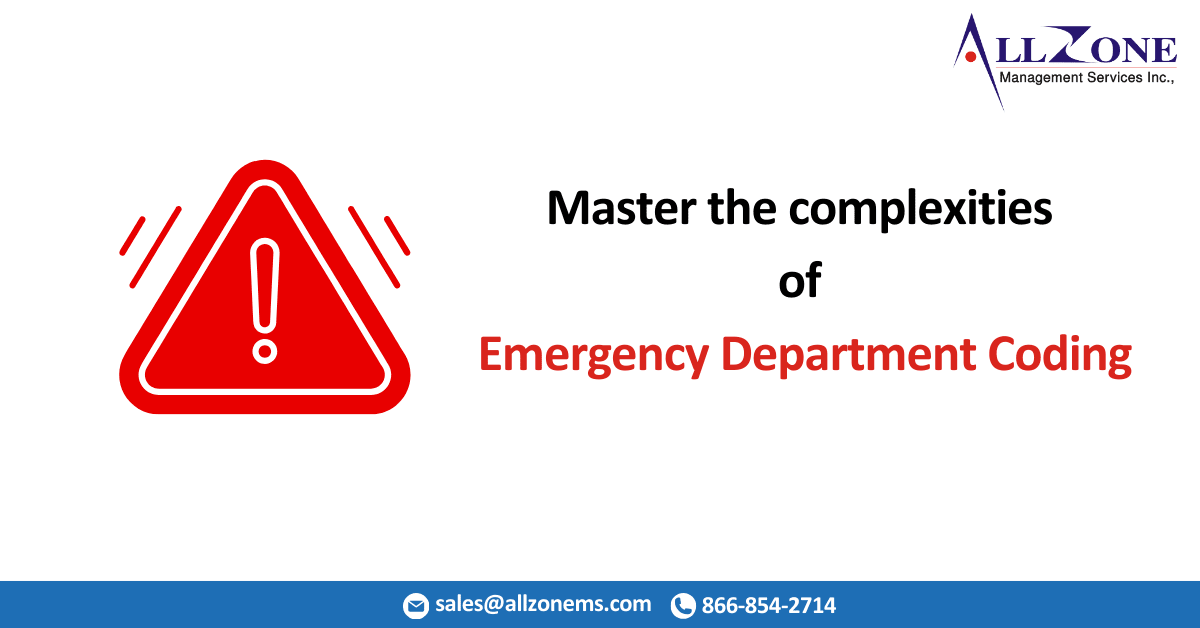Emergency Department coding is a specialized task requiring trained professionals to accurately assign codes to patient encounters. These codes, drawn from the CPT® code set, reflect the complexity of the patient’s condition, the services provided, and the medical decision-making involved.
The Emergency Department Coding Process
Emergency Department coders meticulously review patient documentation, including medical history, physical examination findings, and diagnostic tests. They consider the patient’s chief complaint and presenting problem to select appropriate codes, often guided by the 1995 Medicare documentation guidelines and CPT coding principles. While the 1997 CMS guidelines for specialty exams may occasionally be referenced, they are rarely applicable in the fast-paced ED setting. Additionally, the Marshfield Clinic guidelines can be used to define key components for selecting Evaluation and Management (E&M) codes.
Unique Challenges of Emergency Department Coding
Unlike many other medical specialties, Emergency Department coding is often a separate process. Physicians in the ED typically focus on patient care and documentation, leaving code assignment to specialized coders. This division of labor requires ED coders to possess a deep understanding of a wide range of medical conditions and procedures, from minor injuries to life-threatening emergencies. To ensure accuracy, ED coders undergo rigorous training and regular audits.
CPT Documentation Updates and Emergency Department Coding
While the CPT Editorial Panel introduced updated documentation guidelines in 2025, these primarily affect office visits and do not significantly impact ED E&M coding.
ED Facility Coding and National Standards
While CMS has not issued specific national guidelines for ED facility coding, hospitals generally adhere to widely accepted standards. These standards emphasize the importance of aligning coding with the intensity of hospital resources, focusing on hospital rather than physician resources, and ensuring that documentation requirements are clinically necessary. The prudent layperson standard, which defines an emergency medical condition, is also a critical factor in ED coding and reimbursement.
The Limitations of Final Diagnosis-Based Payment
Relying solely on final diagnoses to determine payment can be problematic in the ED setting. Many patients present with symptoms suggestive of serious conditions, necessitating extensive evaluation and testing. Both the AMA CPT guidelines and EMTALA regulations prioritize the evaluation of presenting symptoms over final diagnoses. Denying payment based solely on final diagnoses can discourage patients from seeking timely care and may conflict with legal requirements.
ED Utilization and Evolving Treatment Paradigms
EDs serve as a crucial safety net for many individuals, particularly those who lack timely access to primary care. While not all ED visits are high-acuity, payment denials based on final diagnoses can deter patients from seeking necessary care. Additionally, advancements in medical care have enabled the effective management of many conditions within the ED setting, reducing the need for hospital admission.
The Importance of Emergency Department (ED) Coding in Medical Coding Companies
Emergency Department (ED) coding plays a crucial role in ensuring accurate documentation, compliance, and reimbursement in the healthcare revenue cycle. The unique challenges of emergency care, such as high patient volumes, complex cases, and rapid decision-making, demand precise and efficient coding practices.
For medical coding companies, ED coding is vital because it directly impacts the financial health of healthcare providers. Proper coding ensures that emergency services, which often include intricate procedures like trauma care, imaging, and critical interventions, are billed correctly to avoid underpayments or denials. For instance, capturing the correct evaluation and management (E/M) levels ensures that the provider’s efforts are adequately compensated.
Additionally, ED coding requires expertise in applying ICD-10-CM, CPT, and HCPCS codes while adhering to payer-specific guidelines. Errors in coding can lead to compliance issues, audits, and revenue loss, making accuracy essential.
Moreover, effective ED coding supports timely claims processing, enabling healthcare facilities to maintain financial stability and focus on patient care. With the growing reliance on outsourcing, a medical coding company specializing in Emergency Department coding can provide significant value by offering expertise, reducing claim rejections, and ensuring a seamless revenue cycle for healthcare providers.
Conclusion
Emergency departments play a vital role in providing timely and critical care. To ensure the sustainability of these services, it is essential to have fair and equitable reimbursement policies that accurately reflect the complexity of ED care. By understanding the unique challenges of ED coding and advocating for appropriate reimbursement, we can support the continued delivery of high-quality emergency care.
Optimize Your Accounts Receivable for Maximum Cash Flow. |

